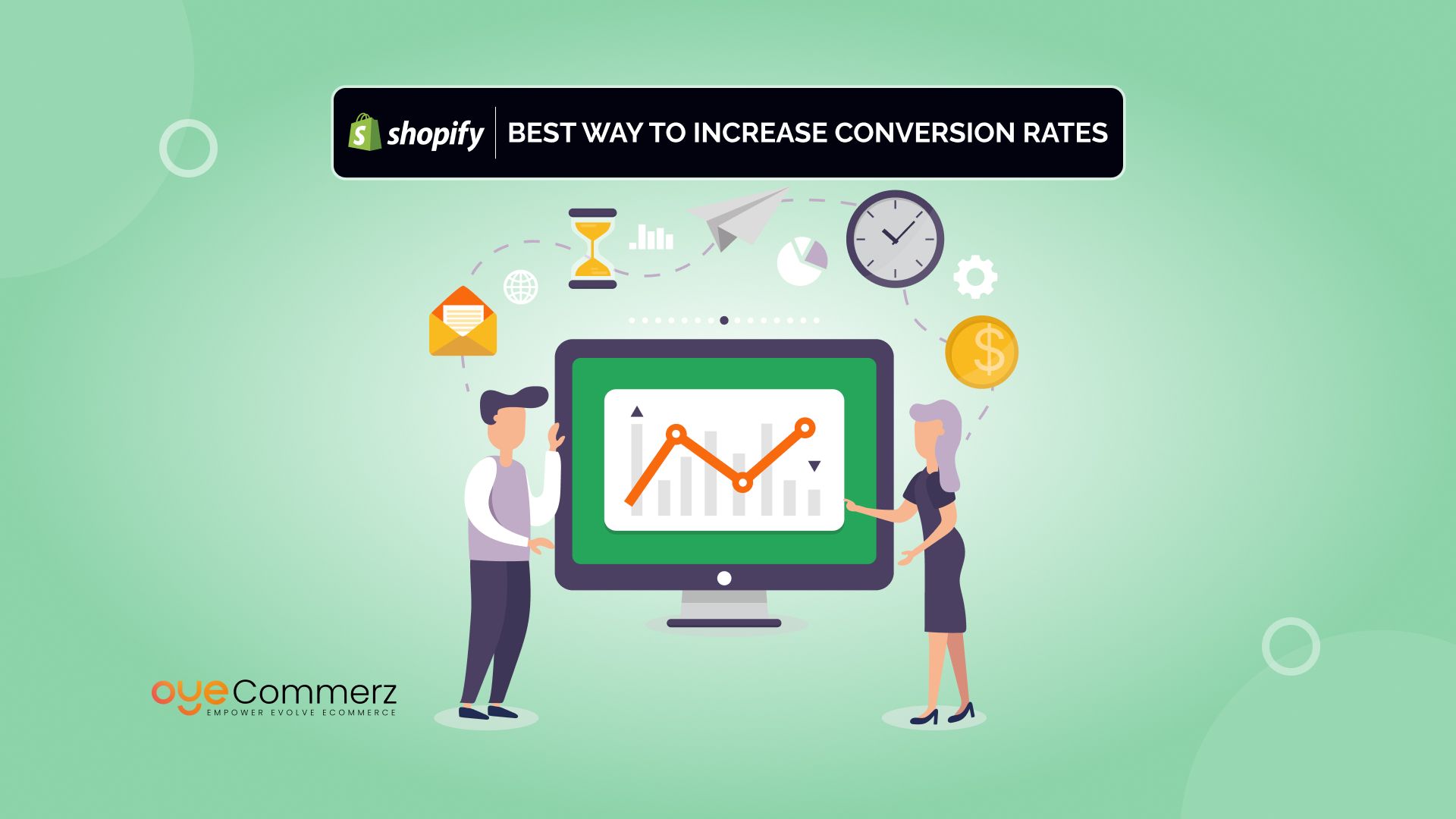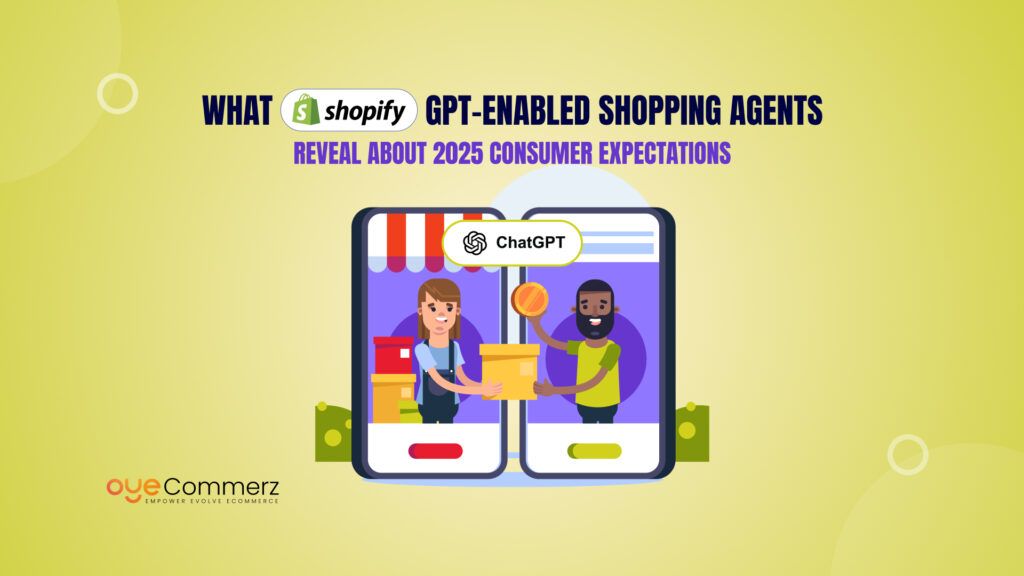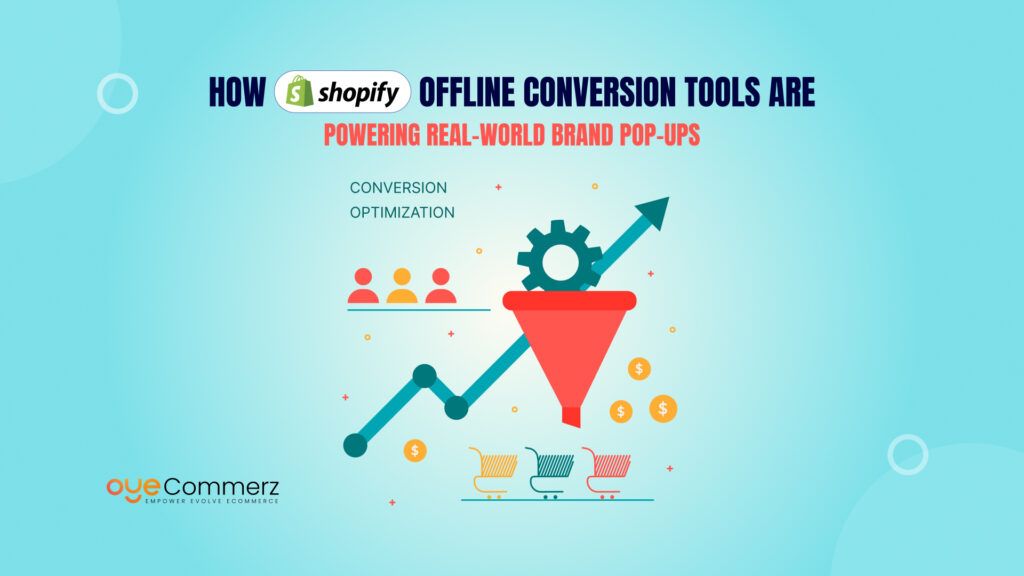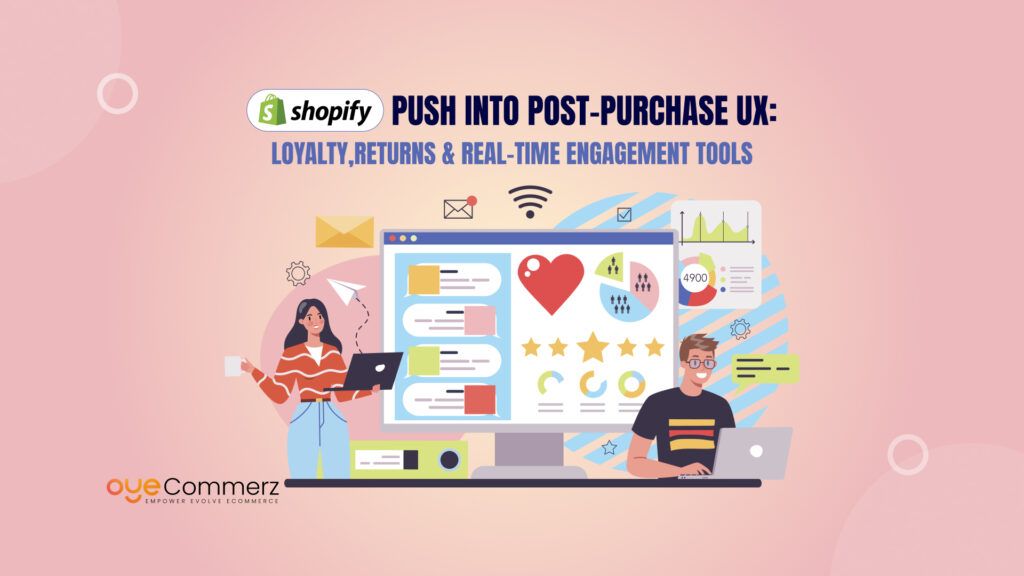Only 1.4% of Shopify visitors convert into customers on average. But here’s the kicker—top-performing stores in the US are hitting conversion rates of 4.7% or higher, all without spending more on ads.
So what separates them from the rest?
That’s the problem most Shopify store owners face: tons of traffic, minimal sales. You might be investing in ads, content, influencers—but your conversion rate just won’t budge. It’s frustrating, especially when every click is costing you.
Now imagine this: instead of throwing more money at traffic, you increase Shopify conversion rates by optimizing what you already have. No more chasing cold leads—just turning warm visitors into loyal customers with smarter, proven strategies.
In this guide, we’ll walk you through exactly how to do that—step by step. Whether you’re just launching your first Shopify store or looking to scale your DTC brand, we’ll cover everything from conversion rate basics to advanced CRO tactics. And if you’re stuck on another platform, we’ll show you how migrating to Shopify (with the right partner) can unlock your store’s true revenue potential.
Table of Contents
ToggleWhy the PAS Framework Works to Increase Shopify Conversion Rates
One of the most effective content and copywriting strategies for improving conversion rates is the PAS framework—Problem, Agitate, Solution. It’s simple but powerful, especially when applied to your Shopify store’s messaging, design, and customer journey.
You’re getting traffic, but sales are low. Bounce rates are high, carts are being abandoned, and customer engagement drops off before checkout. Despite all your efforts, it’s a challenge to consistently increase Shopify conversion rates.
You need a strategic, data-backed approach to conversion rate optimization (CRO). That means understanding buyer psychology, building high-performing product pages, testing relentlessly, and guiding the customer to take action. When applied consistently, the PAS framework doesn’t just help with messaging—it helps you increase Shopify conversion rates across your entire funnel.
Understanding Shopify Conversion Rates: A Beginner’s Guide
Before you can increase Shopify conversion rates, you need to understand what they are, why they matter, and how they’re measured. Whether you’re just starting your online store or trying to get your first few sales, this section will lay the groundwork.
What Is a Conversion Rate on Shopify?
A conversion rate is the percentage of visitors to your store who complete a desired action—most commonly, making a purchase. On Shopify, this is typically tracked as:
Conversion Rate = (Number of Sales ÷ Number of Visitors) × 100
So, if 1,000 people visit your store in a day and 20 of them make a purchase, your conversion rate is 2%.
Why Conversion Rates Matter
Your conversion rate directly impacts your store’s profitability. You can double your sales without increasing traffic—just by improving your conversion rate. It’s one of the most cost-effective ways to grow an e-commerce business.
For example:
- Store A gets 10,000 visitors/month and converts at 1% = 100 sales
- Store B gets the same traffic but converts at 3% = 300 sales
That’s 3x the revenue without spending more on ads or SEO.
What’s Considered a Good Shopify Conversion Rate?
Here’s a general benchmark for Shopify stores:
- Average conversion rate: 1.4% – 2.5%
- Top performers: 3% – 5%+
- Industry leaders: 5% – 7% (typically in niche or highly optimized stores)
The U.S. market tends to have slightly higher averages due to trust factors, faster shipping, and stronger digital infrastructure—but only if your store is optimized for it.
Key Metrics Shopify Tracks for Conversions
- Added to Cart
- Reached Checkout
- Completed Purchase
These stages help you identify exactly where customers are dropping off so you can fix bottlenecks at each stage and steadily increase Shopify conversion rates.
Mobile vs Desktop Behavior
In the U.S., over 65% of e-commerce traffic comes from mobile devices, but desktop users still convert at a higher rate. This gap highlights the importance of mobile optimization—not just making your site look good on mobile, but ensuring it performs seamlessly from product discovery to checkout.
Foundational Fixes: Conversion Basics Most Stores Ignore
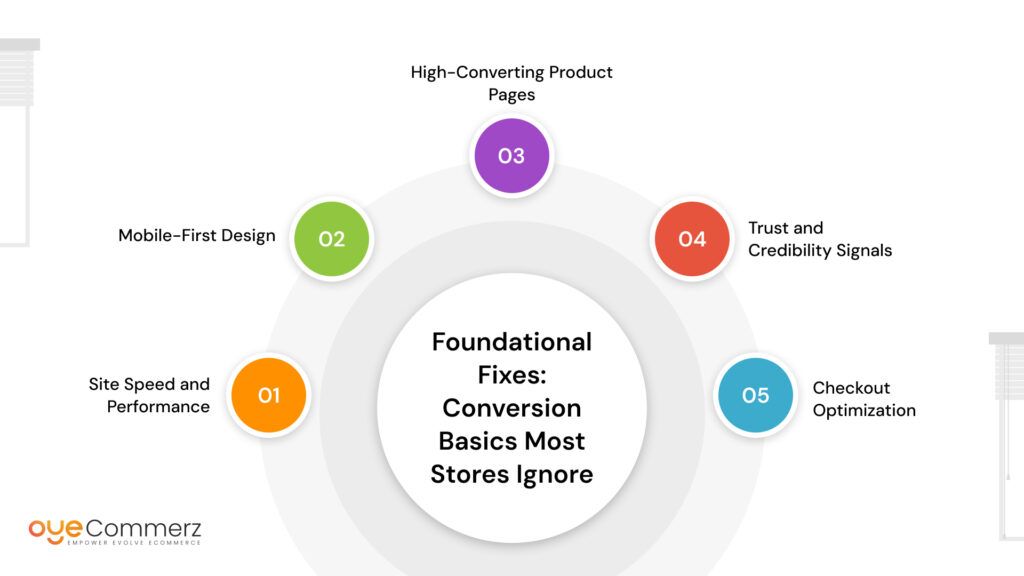
When trying to increase Shopify conversion rates, many store owners jump straight into advanced tactics—A/B testing, upsell apps, or expensive ad retargeting. But what often holds a store back are overlooked basics that quietly kill conversions.
If your store isn’t getting the results you expect, chances are these foundational issues are part of the problem.
1. Site Speed and Performance
Slow-loading websites are conversion killers. In the U.S., users expect a page to load in under 3 seconds. After that, bounce rates skyrocket. Shopify provides a solid backend, but themes, apps, and oversized images can slow your site down fast.
Fixes:
- Compress images without losing quality
- Remove unused apps and code bloat
- Use Shopify’s speed reports and third-party tools like GTmetrix or PageSpeed Insights
A faster site leads to a smoother experience, which helps increase Shopify conversion rates across all devices.
2. Mobile-First Design
With over 65% of e-commerce traffic in the U.S. coming from mobile, your store must be optimized for smaller screens. This isn’t just about responsive design—it’s about performance, navigation, and ease of use.
Best Practices:
- Sticky “Add to Cart” buttons
- Simplified menus and navigation
- Fast, scrollable product pages with minimal friction
A great mobile experience can double your conversions without touching your traffic.
3. High-Converting Product Pages
Your product page is where the decision happens. Weak product pages confuse users or fail to create urgency. Strong product pages guide the user naturally toward a purchase.
Checklist for High-Converting Pages:
- Clear, benefit-driven product titles and descriptions
- High-quality images and lifestyle visuals
- Social proof (reviews, ratings, and testimonials)
- Scarcity or urgency triggers (limited stock, fast shipping)
- Obvious, compelling CTA (e.g., “Buy Now,” not “Learn More”)
4. Trust and Credibility Signals
Trust is essential, especially for new or unknown brands. Without it, customers hesitate, abandon carts, or leave altogether.
Must-Have Trust Signals:
- Verified reviews from past buyers
- Secure checkout badges and payment icons
- Clear return/refund policies
- Contact information and real customer service presence
Adding credibility improves confidence—and that directly increases Shopify conversion rates.
5. Checkout Optimization
According to Baymard Institute, the average cart abandonment rate is over 70%. That means for every 10 people who add a product to cart, only 3 complete the purchase.
Ways to Reduce Drop-Off:
- Enable Shop Pay or one-click payment options
- Eliminate unnecessary form fields
- Show total cost (including shipping) early
- Offer guest checkout
Reducing friction at checkout is one of the fastest ways to recover lost sales and improve your conversion rate.
Top Shopify CRO Tools to Help Increase Shopify Conversion Rates
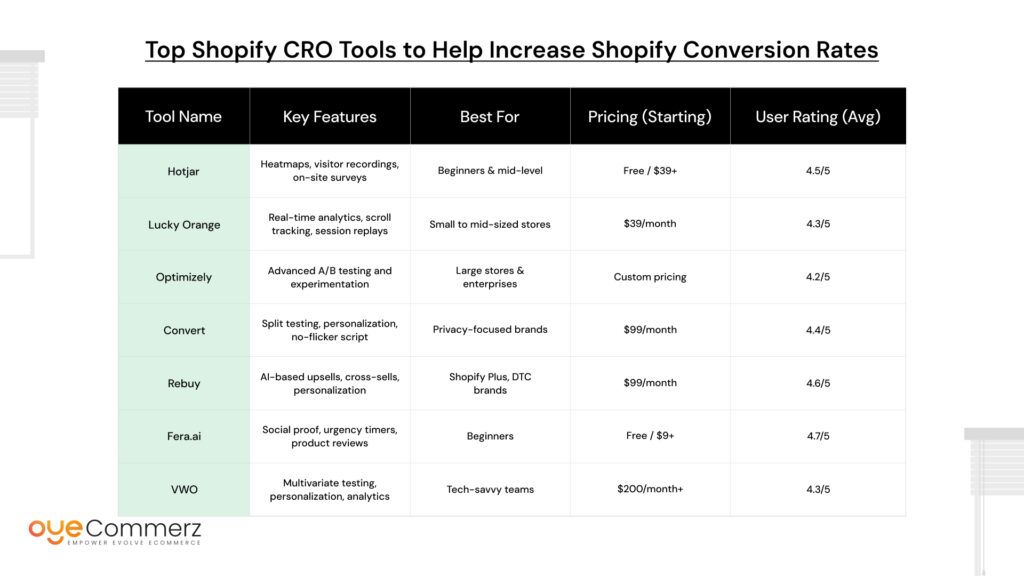
To effectively increase Shopify conversion rates, you need the right tools to track behavior, run tests, personalize content, and streamline the customer journey. The good news? There’s a growing list of powerful apps and platforms built specifically to help Shopify store owners boost performance.
Here’s a side-by-side comparison of some of the most popular CRO tools available for Shopify today:
How to Choose the Right Tool
- For beginners: Start with tools like Hotjar or Fera.ai to get immediate insights and build trust with visitors.
- For scaling stores: Consider platforms like Lucky Orange and Rebuy to dive into personalization and behavioral data.
- For advanced users: Optimizely, Convert, and VWO provide more control over testing and segmentation but come with a steeper learning curve and cost.
No tool alone can fix poor design or a weak offer—but the right one can help you identify what’s working, what’s not, and where to focus your efforts to increase Shopify conversion rates efficiently.
Contact to Migrate your Site to Shopify Now
Data-Driven CRO Tactics for 2025
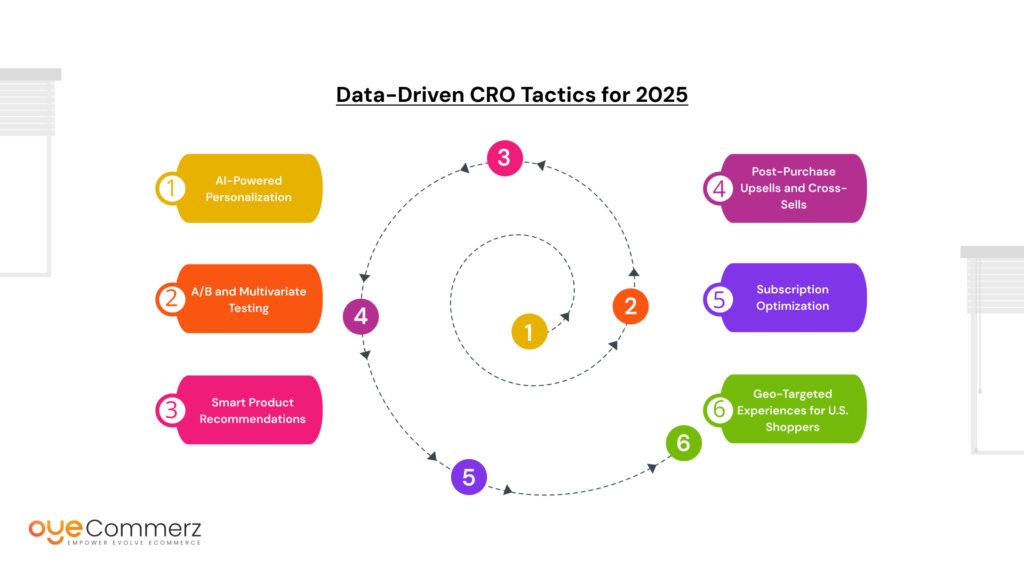
Once your store has the basics in place, it’s time to take a more data-driven approach. These advanced conversion rate optimization (CRO) tactics are designed for stores generating consistent traffic and looking to scale efficiently—without relying solely on ad spend.
These strategies are particularly relevant in 2025, as consumer behavior continues to shift toward personalization, speed, and trust.
1. AI-Powered Personalization
Modern buyers expect tailored experiences. AI-driven apps like Rebuy, Nosto, and LimeSpot dynamically personalize product recommendations, homepage content, and checkout flows.
Use Cases:
- Suggesting items based on browsing or purchase history
- Creating personalized bundles
- Dynamic upsells at checkout
These changes can increase average order value while helping increase Shopify conversion rates across multiple customer segments.
2. A/B and Multivariate Testing
Split testing is no longer optional for high-growth brands. Platforms like Convert or Optimizely let you test headlines, CTA buttons, layouts, pricing models, and more.
What to Test:
- CTA copy: “Buy Now” vs. “Get Yours Today”
- Pricing display: Bundles vs. single-item sales
- Hero image vs. lifestyle video
- Free shipping threshold impact
Data from real customer behavior will guide your decision-making and reveal the combinations that drive the highest conversions.
3. Smart Product Recommendations
Product discovery is a major part of the e-commerce journey. Using machine learning tools to show customers what they’re most likely to buy next can lead to faster decisions and higher cart values.
Implementation:
- “You May Also Like” carousels
- “Others Also Bought” blocks
- On-site search auto-suggestions
These features reduce friction and shorten the path to purchase, which helps increase Shopify conversion rates in real time.
4. Post-Purchase Upsells and Cross-Sells
The checkout doesn’t have to be the end of the customer journey. Tools like Zipify OCU (OneClickUpsell) and CartHook allow you to offer complementary products immediately after a purchase—without disrupting the transaction.
Why it works:
- Customers are already in buying mode
- Upsell acceptance rates post-purchase are higher
- Increases lifetime value without added ad spend
5. Subscription Optimization
Subscriptions are a powerful revenue lever, especially in the health, wellness, and lifestyle verticals. Apps like Recharge or Skio let you create flexible subscription models that boost retention.
Tactics to Try:
- Incentivize subscriptions with discounts or loyalty points
- Offer skip/pause options to reduce churn
- Use behavioral emails to encourage long-term sign-ups
Recurring orders create predictable revenue and contribute to long-term growth while increasing your store’s conversion rate over time.
6. Geo-Targeted Experiences for U.S. Shoppers
With rising expectations for localization, serving personalized experiences based on location is becoming a major CRO differentiator.
What to localize:
- Currency, taxes, and shipping info for U.S. states
- Delivery timeframes
- Location-based promotions (e.g., free shipping in California)
This level of detail builds trust and removes ambiguity—two key ingredients in increasing Shopify conversion rates for U.S. audiences.
How Migrating to Shopify Can Help Increase Conversion Rates

Many businesses struggle with outdated platforms, clunky backends, and limited customization options that directly hurt conversion rates. If you’re facing performance issues, poor mobile experience, or low checkout completion on another platform migrating to Shopify might be your most strategic move.
Shopify offers a streamlined, conversion-focused infrastructure out of the box—designed specifically for modern e-commerce needs. And when done right, migration can lead to a measurable increase in Shopify conversion rates within weeks.
Why Shopify Outperforms Legacy Platforms
- Faster Site Speed
Shopify’s infrastructure is optimized for load time, which directly impacts bounce rates and conversions. - Mobile Optimization
Every Shopify theme is responsive by default, ensuring smoother navigation and checkout on smartphones and tablets. - Secure, High-Converting Checkout
Shopify’s native checkout is tested across thousands of stores, with built-in features like Shop Pay that reduce cart abandonment. - App Ecosystem Built for CRO
Shopify integrates seamlessly with thousands of apps focused on personalization, analytics, social proof, and testing—tools critical to improving conversions. - User-Friendly Admin Panel
Manage promotions, content, and inventory without relying on developers for every change, allowing you to adapt fast.
How Oyecommerz Makes Shopify Migration Easy—and Effective
Migrating to Shopify is more than just moving products and pages—it’s about rebuilding your store for performance, speed, and user experience. That’s where Oyecommerz comes in.
What Oyecommerz Offers:
- Full-service migration from platforms like WooCommerce, Magento, BigCommerce, Wix, and others
- SEO-safe migration to retain rankings and traffic
- Conversion-focused design and UX enhancements post-migration
- Data integrity and order history transfer without downtime
- Ongoing support to ensure smooth Shopify operations
Real Results After Migration
Brands that migrate with a focus on CRO typically see:
- Faster page load times
- Increased mobile conversions
- Reduced cart abandonment
- Higher repeat purchase rates
With Oyecommerz, you’re not just migrating—you’re optimizing.
If your current platform is holding your growth back, it might be time to make the switch. Let Oyecommerz handle the heavy lifting so you can focus on what matters—building a high-performing store that converts.
Conclusion
If you’ve made it this far, one thing is clear—you’re serious about growth. And in today’s competitive e-commerce landscape, it’s not enough to just drive traffic. You need to convert it.
From fixing foundational issues to leveraging advanced CRO tools, everything you do should lead back to one goal: to increase Shopify conversion rates consistently, predictably, and sustainably.
Whether you’re:
- Just getting started with your first store,
- Migrating from another platform and need expert help,
- Or scaling an established brand ready for deeper testing and personalization—
The opportunity is right in front of you. You don’t always need more visitors. You need a smarter path to purchase.
If you’re unsure where to begin, start by identifying and fixing the low-hanging issues—then layer in tools, testing, and strategy. And if you’re not on Shopify yet, or stuck with a platform that limits your performance, migrating with the right partner can change everything.
Oyecommerz is here to help you make that move—smoothly, safely, and strategically—so you can focus on what matters most: growing a store that converts.
Conversion growth doesn’t happen overnight. But with the right systems in place, you’ll stop guessing and start scaling.
Frequently Asked Questions
A strong Shopify conversion rate in 2025 typically falls between 2.5% and 4%, depending on your industry and traffic quality. High-performing stores may see rates above 5%, especially if they’ve optimized for mobile, trust signals, and checkout experience.
This is one of the most common issues for Shopify merchants. High traffic with no sales usually points to conversion friction—such as poor product presentation, unclear value, slow site speed, or lack of trust signals. Performing a full CRO audit can help pinpoint the leaks.
To increase mobile conversions, focus on:
- Fast-loading pages (under 3 seconds)
- Sticky “Add to Cart” buttons
- Easy navigation and clean layout
- Streamlined checkout with options like Shop Pay
Optimizing for mobile is essential since over 65% of e-commerce traffic in the U.S. comes from smartphones.
Some top-performing CRO apps include:
- Fera.ai for social proof and urgency
- Rebuy for smart product recommendations
- Hotjar for behavior insights and heatmaps
Zipify OCU for post-purchase upsells
Choose based on your current challenges—don’t overload your store with too many apps at once.
Yes. Many brands report higher conversions within weeks of migrating to Shopify due to:
- Improved speed and mobile performance
- Better user experience
Streamlined, trusted checkout
With expert help from migration partners like Oyecommerz, your store is built with CRO in mind from day one.
CRO is not a one-time fix. Ideally, you should be:
- Reviewing analytics weekly
- Running A/B tests monthly
Updating content and offers seasonally
Consistent optimization helps keep your store aligned with customer behavior and market trends.

